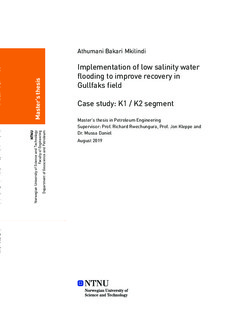| dc.description.abstract | Low salinity water flooding is the type of Enhanced Oil Recovery (EOR) method where the injected water has low salinity than formation water. In recent years, it emerged as one of the most researched EOR in petroleum field. It started in 1967 whereby researchers started the investigation on how salinity of the injected water could affect the efficiency of oil recovery. They claimed that injecting low salinity water in a sandstone formation containing clay improves recovery much better than using brine water.
This research focus on investigating and implementing low salinity water flooding as EOR method in K1/K2 area of Gullfaks field. The objective is mainly achieved through reservoir simulation using ECLIPSE 100 black oil simulator. The data used in this work was found in Gullfaks database. Before simulation the method was screened to validate its suitability in the field. At this stage TechLog a petrophysics software was used to prove the presence of sandstone with clay in the formation which is the strong evidence that low salinity method can be successfully used.
Before formulation of improved simulation cases, a tracer injection work was performed to assess communication in K1/K2 segment. The study concluded that there is no or very limited communication between K1 and K2, layers 11, 12 and 13 communicate with each other and other part of the reservoir, layers 10, 14 and 15 have no communication with each other and with other part of the reservoir, some part of the reservoir have thief zones which will result to loss of fluid if selected for injection.
Two simulation scenarios were formulated. The first scenario involves injection of low salinity water using the three injectors already present in the field, the only work was to convert from injecting sea water to low salinity water. In this scenario the parameter changed were only salt concentration. The second scenario involves the introduction of new injection well. Parameters changed in this scenario were salt concentration and position of injector introduced. This resulted to formulation of five different cases.
The results indicated that salt concentration of 500 ppm improved recovery much better than the rest. The recovery improved from 46.4% to 48.3 and 46.4% to 50.1% for scenario 1 and 2 respectively. In addition, the introduction of the injector increases oil recovery and the economic analysis results showed higher NPV of $ 91,212,346.
Sensitivity analysis performed involved Operating Expenses (OPEX), Oil price, Capital expenditure (CAPEX) and discount rate. All parameters are sensitive to project, but the most sensitive parameter was found to be the oil price having the most impact on the NPV change. For example, increase of oil price by 15% resulted to rise of NPV by 41.7% and 71.67% for scenario 1 and 2 respectively. Also decrease in oil price by 15% resulted to decrease of NPV by 41.7% and 71.67% for scenario 1 and 2 respectively. The result of the analysis was then presented in spider diagrams. The observation from spider diagram is that for both scenario oil price has the most impact on NPV followed by CAPEX, discount rate and the parameter with the least impact is OPEX.
Scenario 1 with no addition injector was finally recommended for possible real field implementation because it was found to have less risk. Analysis performed by changing economical parameters by ±5%, ±10% and ±15% resulted to positive NPV in scenario 1 even in worst case unlike scenario 2 which resulted to negative NPV in worst case.
This work involved only simulation with no laboratory experiment performed. As part of the recommendation for further work, practical side of the work can be performed through core flooding experiments. | |
